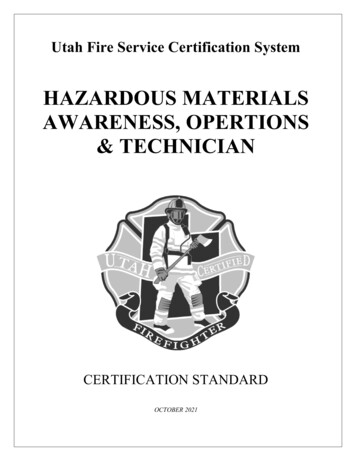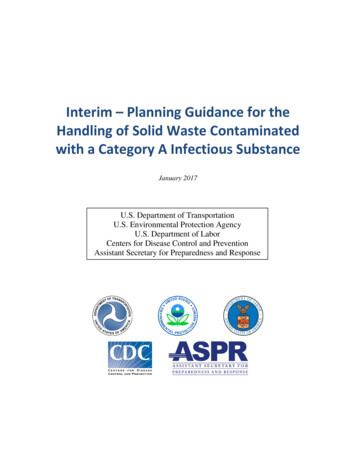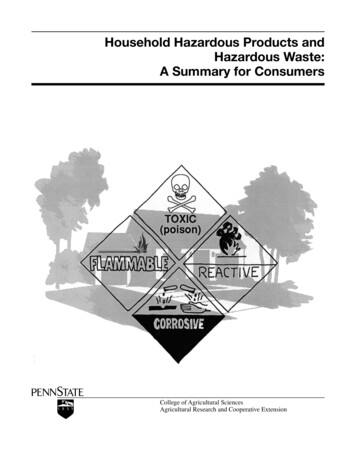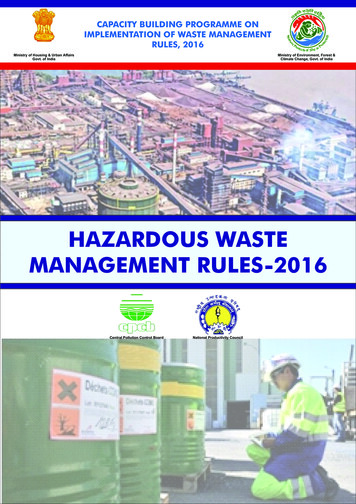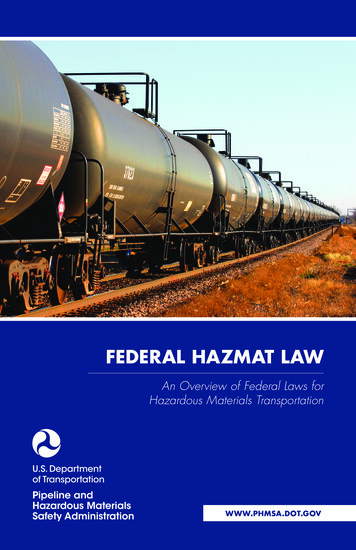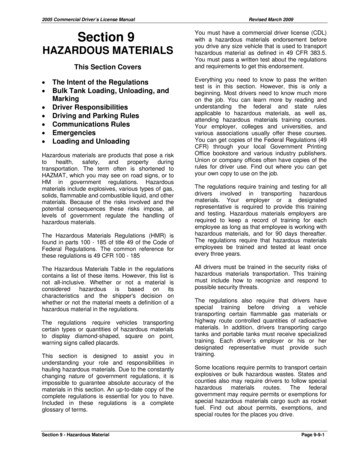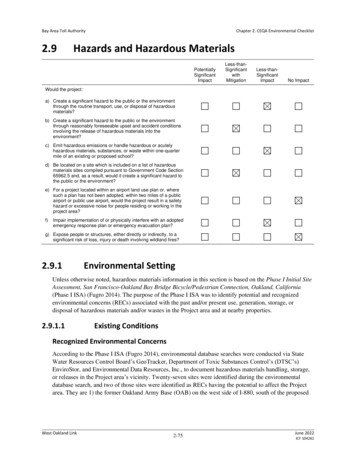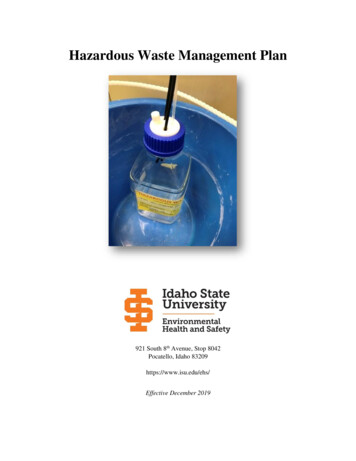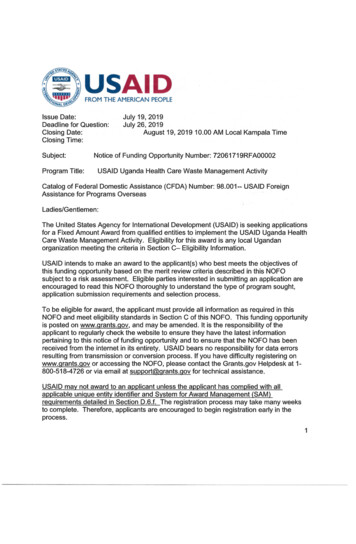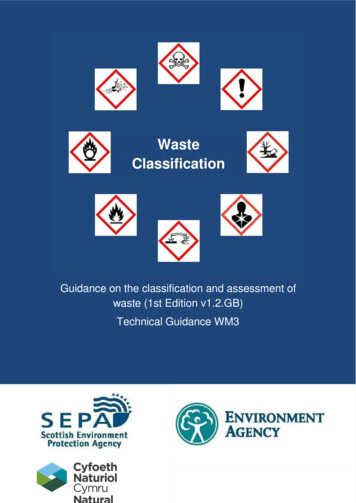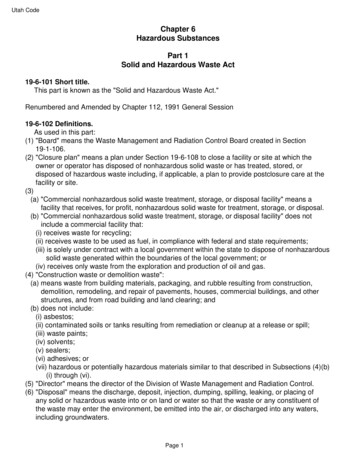
Transcription
HAZARDOUS MATERIALSAWARENESS2019
PREFACEWelcome to the Hazardous Materials - Awarenesscertification course. This course complies with NFPA 472,Standard for Competence of Responders to HazardousMaterials/Weapons of Mass Destruction Incidents, 2018and with NFPA 1072, Standard for HazardousMaterials/Weapons of Mass Destruction EmergencyResponse Personnel Professional Qualifications 2017.Annual refresher training is required for all graduatesof this course in accordance with the code of federalregulations. Refresher training must be of sufficient contentand duration to maintain their certification, or the graduateshall demonstrate competency in those areas at leastyearly (i.e. HazMat exercise, multimedia training, classroomtraining, or participating in an actual HazMat emergencyresponse). This is a mandatory employer requirement tocomply with the law (29 CFR 1910.120-q-6)The State Emergency Response Commission requires 4hours per year of continuous education to retain certificationper year (i.e. HazMat exercise, multimedia training,classroom training, WMD training or participating in anactual HazMat emergency response).
Learning Objective 1Hazardous Materialsfor First RespondersFifth EditionDefine a hazardous materials incident.Chapter 1 — Introduction toHazardous Materials1–1Hazardous materials are substancesthat possess harmful characteristics.WMDs have the potential to causemass casualties and damage.WMD Weapons of Mass icalNuclear1–21–3Hazmat/WMD incidents poseunreasonable risks.ExplosiveHazmat incidents have manypotential causes.A hazardous materials/WMD incidentis an emergency involving substancesthat pose unreasonable risk toPotentialCauses ofHazmatIncidentsHuman errorMechanical breakdowns or malfunctionsContainer identsDeliberate acts1–4Chemical suicidesWMD incidents1–51
Container failure is one way that ahazmat incident may occur.Hazmat incidents are often morecomplex than other types of incidents.HazmatincidentsmayPresent a variety of dangers,sometimes in small quantitiesBe extremely difficult to containand/or controlCourtesy of Barry LindleyRequire specialized equipment,procedures, PPEBe difficult to detect, requiringsophisticated monitoring equipment1–61–7REVIEW QUESTIONCAUTIONHazardous materials incidents are notalways clearly defined before firstresponders arrive. You must beconstantly alert to the presence ofhazardous materials and their possibleeffects on the incident. Whetherinvolved or not, the mere presence ofhazardous materials may changeincident’s dynamics.How are hazardous materials incidentsdifferent from other types of emergencyincidents?1–8Learning Objective 2Describe roles and responsibilities of firstresponders in hazardous materialsincidents.1–101–9Hazmat first responders must safelyrespond to hazmat incidents.You must understandRole you playin theseincidentsYourlimitationsWhen youcannotproceed anyfurther1–112
First responder roles are establishedby law and NFPA standards.NFPAConsensusStandardsthat applyto hazmatrespondersNFPA 1072, Standard for HazardousMaterials/Weapons of Mass DestructionEmergency Response PersonnelProfessional QualificationsNFPA 472, Standard for Competence ofResponders to HazardousMaterials/Weapons of Mass DestructionIncidentsNOTEIndividuals who train to meet NFPA1072 will meet or exceed OccupationalSafety Health Administration (OSHA)requirements for Awareness,Operations, and Technician.NFPA 473, Standard for Competencies forEMS Personnel Responding to HazardousMaterials/Weapons of Mass DestructionIncidents1–12Three training levels are addressedin this manual.Awareness level personnel performlimited defensive actionsOperations responders performdefensive actionsOperations Mission-Specificresponders may be trained toperform additional defensive andlimited offensive actions1–13NFPA also identifies responsepersonnel who perform more complexoperations at hazmat incidents.Hazardous Materials TechnicianHazardous Materials Technician SpecialistHazardous Materials Incident CommanderHazardous Materials OfficerHazardous Materials Safety OfficerSpecialists1–14APIE can help responders devise a4-step response to any hazmat incident.1–15Not all aspects of APIE areaddressed at the Awareness level.Componentsof APIE 3
Awareness level personnel might befirst to arrive at a hazmat incident.Awareness level personnel shouldtransmit, protect, and isolate.1–18Awareness level responders must beaware of clues to help them recognizehazardous materials.Clues thatmayindicate thepresence ofhazardousmaterialsLocationContainer shapeTransportation or facility markings1–19Awareness responders are notresponsible for planning the responseto a hazmat ering devicesMay provideinitial actionsto be takenSensory input such as odor, taste,appearance1–20Awareness personnel play animportant role at hazmat incident.Initial actions can affect course of incident for better or worseExpected to transmit information to appropriate authoritiesCall for appropriate assistanceInitiate protective actions1–21Ops level personnel respond to hazmatreleases as part of their normal duties.Operationslevelrespondersmust beable toID potential hazardsID response optionsImplement planned response tomitigate or control releaseEvaluate progress of actions takenIsolate hazardous area and deny entry1–221–234
Ops level responders are expected toidentify potential hazards.Ops responders should determinewhere the release has occurred.Type of container involvedHazardous material involvedCourtesy of Barry LindleyHazards presented by materialPotential behavior of material1–241–25Ops responders do not plan theactual response.Operationsrespondersmust beable toID response optionsUnderstand tasks they may beassignedOperations responders helpimplement the response.Operationsrespondersare expectedtoEstablish Incident Management SystemEstablish scene controlImplement protective actions such as evacuationFollow safety proceduresUse PPE in proper mannerProtectthemselvesSafety precautionsAvoid hazards and complete assignmentsSuitability of PPEPerform emergency decontaminationEmergency decon needsID and preserve potential evidence if crime suspected1–26Operations level personnel may betrained beyond core competencies.1–27Operations Mission-Specific trainingmay include using specialized PPE.Mission-specific specialized competencies PPE Mass decon Technical decon Evidence preservation and sampling Product control Air monitoring and sampling Victim rescue and recovery Response to illicit laboratory incidents1–281–295
REVIEW QUESTIONLearning Objective 3What are the three levels of hazmatresponders and what are theirresponsibilities?Recognize the ways that hazardousmaterials harm people.1–301–31Hazardous materials can hurt you invarious ways.You must understand hazmatincidents to safely mitigate them.Variety of hazardous materials you mayencounterMay cause harmby their behaviorand/or physicalpropertiesMay affect healthif they contact orget into you bodyPotential health effects of materialsPhysical hazards associated with them1–321–33Many hazardous materials havepotential health effects.Health affects may beAcuteChronic1–34Delayed1–356
Hazardous materials can enter thebody in multiple ways.Inhalation is the most commonexposure route.InhalationBreathinghazardousmaterials inthrough yournose or mouth1–36Poor hygiene can lead to accidentalingestion.Ingestion1–37Some materials easily pass throughskin and mucous membranes.AbsorptionEating orswallowinghazardousmaterials throughyour mouthTaking in materialsthrough your skinor eyes1–38Sharp objects can cut or punctureyour skin.1–39Hazardous materials can harm you inthree ways.InjectionTaking in materialsthrough apuncture in yourskin1–401–417
Energy release at hazmat incidentspresents the greatest threat.Heat (thermal) hazards are commonat hazmat incidents.Hazardous material can cause temperature extremesFires, explosions, burnsEnvironmental factors can cause heat illness,complicate hazmat operationsLack of heat can also cause harm1–42Heat and lack of heat can both causeharm.ThermalEnergyHazards1–43Objects possess mechanical energydue to their position or motion.Elevated temperature materialsExothermal reactionsFires and explosionsHot weatherCryogenic liquids and gasesResponders canbe injured byflying or fallingobjectsFriction injuriesmay occur –abrasions,blisters, burnsCold temperatures1–44Pressurized materials can releaseviolently.Hazardous material stored under pressureCan release violentlyMaterials may expand rapidly1–45Electrical hazards and electricitymay be present at hazmat ed containersElectrical equipment Portable generatorsPower toolsSpread hazards quickly over potentially large areas1–461–478
Potential for radiation exposureexists at different types of incidents.Chemical energy is released whenmaterials undergo chemical reactions.ChemicalenergyhazardsPotential forradiationexposureFlames or explosionRelease heatMedical centersIndustrial operationsNuclear power plantsUse heatResearch facilitiesCreate new hazardous materials withnew/different hazardsTerrorist attacks1–481–49Corrosives are chemicals thatdestroy or burn living tissues. Can hurt if theycontact skin or body May damage toolsand equipment1–50Effects may beCourtesy of CDC Public Health Image LibraryCorrosivematerialsToxic substances cause damage onthe molecular scale. Fast-acting, acute Chronic, notmanifested formany yearsSmallpox virus can cause harm.1–51REVIEW QUESTIONSLearning Objective 4What are the four main routes of entrythrough which hazardous materials canenter the body and cause harm?List hazardous materials regulations,definitions, and statistics.What are the three main mechanisms bywhich hazardous materials can causebodily harm?1–521–539
Many deadly incidents have affectedthe emergency response community.Four main U.S. federal agencies areinvolved in the regulation of hazmat.Department of TransportationCourtesy of Moore Memorial Library, Texas City, TX(DOT)Environmental Protection Agency(EPA)More than 500people were killedand over 3,000injured when a shipcarryingammonium nitratefertilizer explodedat a dock.Department of Labor(DOL)Nuclear Regulatory Commission(NRC)1–541–55The DOT issues transportationregulations.Courtesy of U.S. Environmental Protection AgencyCourtesy of Ray ElderDOT regulationsregarding placardswere changed after anunmarked trailercontaining 50,000pounds of ammoniumnitrate exploded inKansas City killing sixfirefighters.The EPA sets national standards forenvironmental programs.The resulting healthproblems from LoveCanal led to thepassage of , andLiability Act (CERCLA).1–56Divisions of the DOL regulate workersafety, hazardous household products,and radioactive materials.OSHAOccupational Safety and Health AdministrationWorker safetyHazardous chemicals, hazardous substances, highlyhazardous chemicalsCPSCConsumer Product Safety CommissionSeveral other U.S. agencies are alsoinvolved in the regulation of hazardousmaterials.Department of EnergyDepartment of Homeland SecurityConsumer Product Safety CommissionHazardous household productsChemical products intended for consumersNRC1–57Nuclear Regulatory CommissionRadioactive materialsUse, storage, and transfer1–58Department of Defense Explosives Safety Board (DDESB),Department of Defense (DOD)Bureau of Alcohol, Tobacco, Firearms and Explosives (ATF),Department of TreasuryDepartment of Justice1–5910
In Canada, four main agenciesregulate hazardous materials.Transport Canada (TC)Environment CanadaHealth CanadaCanadian Nuclear Safety Commission (CNSC)1–60All first responders will likely have todeal with a hazmat incident.MosthazmatincidentsinvolveThree main Mexican agenciesregulate hazmat.Secretaría de Comunicaciones y Transportes(SCT) – Ministry of Communications andTransportSecretaría de Medio Ambiente y RecursosNaturales (SEMARNAT) – Ministry ofEnvironment and Natural ResourcesSecretaría del Trabajo y Prevision Social(STPS) – Ministry of Labor and Social Welfare1–61Transportation hazmat incidents arecommon.Flammable/combustible liquidsCorrosivesAnhydrous ammoniaStatistics indicate that mosttransportation incidents occur whilematerials are being transported byhighway rather than air, rail, orwater.Chlorine1–621–63REVIEW QUESTIONWhy are there so many regulationsinvolving hazardous materials?1–6411
Learning Objective 1Hazardous Materialsfor First RespondersFifth EditionChapter 2 — Analyzing the Incident:Recognizing and Identifying thePresence of Hazardous MaterialsRestate the seven clues to the presenceof hazardous materials.2–1There are seven clues to thepresence of hazardous materials.Moving closer to a hazardousmaterial increases risk.Occupancy types, locations, preincident surveysContainer shapesTransportation placards, labels, and markingsOther markings and colors (nontransportation)Written resourcesSensesMonitoring and detection devices2–22–3Mixed loads in transportation maynot be marked at all.REVIEW QUESTIONList the seven clues to the presence ofhazardous materials.Courtesy of Rich Mahaney2–42–51
Preincident plans can simplify andreduce on-site decisions.Learning Objective 2PreincidentsurveysidentifyExplain how preincident plans, occupancytypes, and locations may indicate thepresence of hazardous materials.ExposuresHazmat types, quantities, dangers, locationsBuilding features such as location of fixed firesuppression systemsSite characteristicsPossible access/egress difficultiesInherent limitations of response organizations whentrying to control certain types of hazmat emergencies24-hour telephone numbers of responsible parties andsite expertsSite or occupancy response capability2–62–7Certain occupancies are likely tohave hazardous materials.Certain occupancies are likely tohave hazardous materials.Fuel storagefacilitiesGas/servicestations andconveniencestoresPaint supplystoresPlant nurseries,garden centers,agriculturalfacilitiesPest control,lawn carecompaniesMedical facilitiesPhoto processinglaboratoriesPlastics MercantileconcernsLumberyardsFeed/farm storesVeterinary clinicsPrint shopsDry cleanersWarehousesIndustrial andutility plantsPort shippingfacilitiesTreatmentstorage disposal(TSD) facilitiesLaboratories ineducationalfacilitiesAbandonedfacilitiesBig box retailstoresShipping arm stores are likely to havehazardous materials in stock.The presence of fume hood exhauststacks indicates a laboratory.Courtesy of Rich Mahaney2–102–112
Residential occupancies have manyhazardous chemicals.Hazmat accidents are more likely tooccur during transfer or handling.Hazmat transfer locationsPorts2–12Docks s2–13Port facilities are a common locationfor hazmat incidents.Railway bridges and trestles arelikely spots for hazmat incidents.Courtesy of Phil LinderCourtesy of U.S. Customs and Border Protection,photo by Charles Csavossy2–142–15Hazardous materials may bereleased during flooding.REVIEW QUESTIONWhat types of occupancies are most likelyto have hazardous materials?Courtesy of Rich Mahaney2–162–173
Learning Objective 3Containers provide useful informationabout the materials inside.Identify basic container shapes thatindicate the presence and hazards ofhazardous materials.2–18Hazmat containers are sometimesclassified by transport mode.2–19Containers can also be classified bycapacity.2–202–21Bulk packages are loaded with nointermediate form of containment.Bulk packaging criteria is by volume,mass, or weight.BulkpackagingincludesLiquidCargo tanks Maximum capacity 119 gallons (475 L)RailcarsPortable tanksIntermediate bulk containers (ICB)Intermodal containers (IM)2–22Solid Maximum net mass 882 pounds (440 kg) Maximum capacity 119 gallons (475 L)Gas Capacity 1,001 pounds (500 kg)2–234
Nonbulk packaging is smaller thanthe criteria for bulk packaging.Nonbulk packages have some typeof intermediate oysBagsComposite packagesCombination packages2–24Compressed gas cylinders are afamiliar type of pressure container.2–25Pressure containers can ruptureviolently due to internal pressure.2–26A pressurized gas will expand rapidlyif released into the environment.2–27WARNINGSTOP!!! Products stored in pressurecontainers may kill you! As a responder,your job is to stop and stop others!Isolate and deny entry.When damaged or stressed by heat orflames, pressure containers mayexplode! Keep your distance!2–282–295
WARNINGWARNINGContents of pressure containers mayignite easily and will expand quickly ifreleased! Keep your distance upwind,uphill, and upstream! Remove ignitionsources if it can be done safely!Contents of pressure containers may beextremely toxic and will expand quicklyif released! Keep your distance upwind,uphill, and upstream!Contents of pressure containers may becorrosive and will expand quickly ifreleased! Keep your distance upwind,uphill, and upstream.2–302–31Pressure containers may have rounded,spherical ends or bolted manways.Pressure containers may have boltedprotective housings.Pressure containers may havepressure relief devices.Courtesy of Rich MahaneyCourtesy of Rich Mahaney2–322–33Pressure containers may havepressure gauges.Courtesy of Rich Mahaney2–342–356
Pressure containers vary.Cryogenic containers store andtransport cryogens.Cryogen Sometimes called refrigerated liquefied gas Gas that turns into a liquid At or below -130̊ F (-90̊ C) At 14.7 psi (101 kpa) {1.01 bar}2–362–37Cryogens may change rapidly from aliquid to a vapor when released.Vapor clouds may beflammable, toxic,corrosive, or anoxidizerVapors may beextremely cold,potentially causingfreezing burns2–38WARNINGCryogens can displace oxygen andcause asphyxiation!Cryogens are extremely cold and canseverely injure you if contacted!2–39Contents are a clue to cryogeniccontainers.CAUTIONImmediately remove any clothingsaturated with a cryogenic material.Cryogenic contents include Liquid oxygen (LOX) Nitrogen Helium Hydrogen Argon Liquefied natural gas (LNG)2–402–417
Box-like loading and unloading stationsattached to transportation containersindicate a cryogenic container.Cryogenic containers vary.2–42There are many types of �43Liquid containers may hold contentsthat have a variety of hazards.PressureGasoline containersHeatPaint pailsReactivityDrumsFixed facility UTIONSTOP!!!! Products in liquid containersmay kill you! Your job as a responder isto stop and to stop others! Isolate anddeny entry.Many liquid containers will have lowamounts of pressure. When released,this pressure may cause contents tosplash or spray.Liquid containers may explode whendamaged or stressed by heat or flames.Keep your distance!Liquid containers may hold toxics,corrosives, or materials with a variety ofpotential heat hazards. Do not come incontact!2–462–478
There are clues to liquid containers.Know the clues to liquid containers.Flat (or less rounded) ends on tanksLow pressure rail tank cars may have multiple fittings visible on topHighway cargo tanks will haveoval, upside-down horseshoeshaped, or circular shaped endswith less rounding than pressuretanksIntermodal, flexible intermediate bulk containers and rigidintermediate bulk containers designed to be stackedFlat ends on tanksAccess hatches secured with easily removed latching devicesFlexible bladders filled with fluidsIntermodal, flexible intermediatebulk containersHighway cargo tanks will have oval, upside-down horseshoe-shapedor circular-shaped ends with less rounding than pressure tanks2–482–49Solids containers may have systemsdesigned for pneumatic loading andunloading.Solids containers and hazards vary.SomesolidshazardsMay be toxic or corrosiveMay release energyMay be reactiveCourtesy of Rich MahaneyMay engulf, suffocate, or crushAirborne particles may explode2–502–51Solids containers may have open topsor be covered with tarps or plastic.Courtesy of David Alexander, Texas Commission onFire Protection2–52WARNINGDust explosions can kill you!Solid materials can engulf and kill you!2–539
Radioactive material is shipped inone of five basic types of containers.Type B packages must withstandsevere accident conditions.Retains and protects contents duringnormal transportation activitiesCourtesy of the National Nuclear SecurityAdministration, Nevada Site OfficeOnly used to transport materials withextremely low levels of radioactivity thatpresent no risk to public or environmentMust demonstrate ability to withstandseries of tests without releasing contentsMust demonstrate ability to withstandtests simulating normal shippingconditions and severe accident conditionsVery rare packaging used for high-activitymaterials transported by aircraft2–542–55Many hazardous materials aretransported in underground pipelines.CAUTIONRadiation can travel in all directions forlong distances and may pass throughmaterials. It cannot be detected by thefive human senses and requires a meterto detect.Courtesy of Rich Mahaney2–56Markers are often the best way to IDpipelines and their contents.2–57WARNINGPipelines can transport high pressurematerials and may explode!Pipelines can transport a variety of verydangerous materials!2–582–5910
Marine vessels transport over ninetypercent of the world’s cargo.CAUTIONPipelines may be buried in residentialneighborhoods!Vessel Cargo CarriersTankers(tank vessel)Transport verylarge quantitiesof liquidproducts2–60Tankers often carry differentproducts in segregated tanks.Transport crude or finishedpetroleum productsCargovesselsTransportliquids or solidsBargesCan transportanything2–61There are four types of cargo vessels.Bulk carriersBreak bulk carriersTransport many differentchemical productsTransport LNG and LPG2–62Container vessels transport cargo instandard intermodal containers.2–64Container vesselsRoll-on/Roll-off vessels2–63Roll-on/roll-off vessels have rampstructures that allow vehicles to bedriven on and off the vessel.2–6511
Barges can travel waterways thatlarger vessels cannot.WARNINGConfined spaces in vessels can containoxygen deficient atmospheres thatcause asphyxiation!2–662–67Unit loading devices consolidate aircargo into a single, transportable unit.ULDs are containers and aircraftpallets.Designed and shaped to fit into airplanedecks and compartmentsIn some cases may be stackedCourtesy of Jon Deyman2–68Hazardous materials shipped in ULDs mustbe appropriately placarded and labeled2–69REVIEW QUESTIONNOTEMilitary aircraft or transport vehiclesmay transport Internal airlift andhelicopter Slingable Units (ISUs) thattransport everything includinghazardous materials.2–70How can you differentiate pressure,cryogenic, liquid, and solids containersfrom a distance, and what types ofhazardous materials are each likely tocontain?2–7112
REVIEW QUESTIONREVIEW QUESTIONSList the five basic types of containersused to transport radioactive materialsand briefly explain what these packagesare designed to withstand.What types of hazardous materials aretransported in pipelines?What are unit loading devices and canhazardous materials be shipped in them?2–72Learning Objective 42–73Transportation placards, labels, andmarkings identify hazmat duringtransportation in North America.PlacardsDescribe ways that U.S. transportationplacards, labels, and markings indicatethe presence and hazards of hazardousmaterials.LabelsNonbulkpackagingBulk PackagingSome uniquelabels with noplacard equivalent2–74The U.N. system designates ninehazard classes.2–75Four-digit UN ID numbers must bedisplayed on bulk containers.Class 1: ExplosivesClass 2: GasesClass 3: Flammable LiquidsClass 4: Flammable solids, substances liable to spontaneous combustion,substances that emit flammable gases on contact with waterClass 5: Oxidizing substances and organic peroxidesClass 6: Toxic and infectious substancesClass 7: Radioactive materialsClass 8: Corrosive substancesClass 9: Miscellaneous dangerous substances and articles2–762–7713
Placards identify a container’scontents.NOTENA numbers (North America) alsoknown as DOT numbers, are issued bythe United States Department ofTransportation and are identical to U.N.numbers, except that some substanceswith a U.N. number may have an NAnumber. These additional NA numbersuse the range NA8000-NA9999.2–78Placards are color coded by hazardclass.2–80The placard may also have a hazardsymbol.2–822–79More than one placard indicates thatmore than one hazard or product ispresent.2–81The lower corner of a placard displaysthe hazard class or division number.2–8314
The Dangerous placard is for mixedloads of nonbulk packages.2–84Labels are 3.9 inch (100 mm)square-on-point diamonds.2–85Packages with more than one labelhave more than one hazard or product.Markings provide importantinformation to first responders.Courtesy of Rich Mahaney2–86Elevated temperature materials aremarked as “Hot.”2–87Materials marked as “Hot” should betreated as burn hazards.ElevatedLiquid phase at a temperature at orTemperature above 212 F (100 C)MaterialCourtesy of Rich MahaneyLiquid phase with a flash point at orabove 100 F (38 C) that isintentionally heated and offered fortransportation or transported at orabove its flash pointSolid phase at a temperature at orabove 464 F (240 C)2–882–8915
REVIEW QUESTIONREVIEW QUESTIONWhat are the nine hazard classes used bythe U.N. to categorize hazardousmaterials?How does the U.S. transportation systemof placards, labels, and marking indicatethe hazards posed by the hazardousmaterials carried?2–90Learning Objective 5Describe ways that Canadiantransportation placards, labels, andmarkings indicate the presence andhazards of hazardous materials.2–91Canadian placards, markings, and labelsare also based on U.N. recommendations.DifferencesbetweenCanadianand U.S.placards,labels, andmarkingsMost Canadian transport placards do nothave signal wordsLabels and markings may be in both Englishand FrenchCanada requires a unique placard foranhydrous ammonia and Inhalation HazardsRadiation placard may have the four-digitU.N. number2–922–93REVIEW QUESTIONLearning Objective 6How do Canadian placards, markings, andlabels differ from the U.S. system?Describe ways that Mexicantransportation placards, labels, andmarkings indicate the presence andhazards of hazardous materials.2–942–9516
Mexican placards, markings, and labelsare also based on U.N. recommendations.Mexican placards, markings, and labelsare almost identical to U.S. and Canadian.Mexico does notrecognize inhalationplacardDifferences betweenMexican and U.S.placards, labels, andmarkings2–96May have text inSpanish2–97REVIEW QUESTIONLearning Objective 7How do Mexican placards, markings, andlabels differ from the U.S. system?Identify other markings and colors thatindicate the presence of hazardousmaterials.2–982–99Other markings and colors may alsoindicate the presence of hazmat.NFPA 704 System can be used infixed-storage facilities.Courtesy of Rich Mahaney2–1002–10117
There are two special hazardssymbols in the NFPA 704 System.WOXUnusualreactivitywith waterNOTEThe NFPA 704 system may be useddifferently in countries outside of NorthAmerica. For example, NFPA 704symbols might be used ontransportation containers.Oxidizer2–1022–103GHS promotes consistent criteria forclassifying chemicals.CAUTIONThe NFPA 704 diamond will relay theworst hazard level in each category onsite. These may not all be from thesame material.GloballyUniform classification ofHarmonized hazardous substances andmixturesSystemUniform labeling standardsUniform SDS content and format2–104Universal symbols and pictogramsare part of GHS.2–105HCS requires employers to IDhazards in the workplace.Employers must Identify hazards in workplace Train employees to how to recognizethose hazards Ensure all hazardous materialscontainers are labeled, tagged, ormarked with identity of the substancesand appropriate hazard warnings2–1062–10718
OSHA requires employers to IDhazards in the workplace.HMIS complies with HCS standards.HMISHazardous Materials Information SystemCommonly used proprietary systemDeveloped by American Coating AssociationFirst responders may encounter avariety of different identificationsystems used by employers in theirarea.Utilizes numerical rating and color code2–108WHMIS is the Canadian workplacehazmat labeling system.2–109Canadian employers will most likelyuse the Supplier or Workplace label.Workplace Hazardous Materials Information Systems Requires hazardous products be appropriatelylabeled and marked Spells out requirements for SDS Supplier and Workplace labels most commonlyused2–110GHS is replacing the old WHMISsystem.2–111The Mexican hazard communicationsystem is Essentially adopts NFPA 704Employers can use alternativesystems if they comply withobjective and purposeGeneral caution systems aretriangular2–1122–11319
The shape of general cautionsymbols differ by country.CAS numbers identify a specificcompound.Courtesy of Rich Mahaney2–114Military markings may be unique2–115U.S. and Canadian military markingsare pictograms.Used on fixed facilitiesMilitarymarkingsMay be on vehicles (not required)Not uniformFor security reasons, not all hazmatwill be marked2–116Pesticides must be labeled.2–117This container of herbicide is labeledaccording to EPA regulations.Pesticide labels include(in accordance with GHS include) EPA or Canadian PCP number Hazard statement(s) Pictogram(s) Precautionary statement(s) Product identifiers Signal word Suppli
training, or participating in an actual HazMat emergency response). This is a mandatory employer requirement to comply with the law (29 CFR 1910.120-q-6) The State Emergency Response Commission requires 4 hours per year of continuous education to retain certification per year (i.e. HazMat exercise, multimedia training,
